A varminter needn’t be cumbersome to be accurate.
One of the most interesting new rifles I’ve seen in recent months is the Model 25 Lightweight Varminter from Savage. It’s a startling departure from the 110 series of rifles the company has produced for more than a half-century.
Highly successful because of its accuracy and low cost, the Model 110 was designed for manufacturing ease. It combines stamped steel and investment-cast components with a sturdy action and barrel precision machined from forged steel.
The Model 25 receiver is a dead ringer for Savage bolt-action .22 rimfire receivers.
There are three Model 25 variations. The Lightweight Varminter T has a thumbhole stock and a ventilated fore-end. The Walking Varminter has a synthetic stock and weighs just under 7 pounds. The Lightweight Varminter has a laminated stock, wide fore-end and a Monte Carlo style buttstock.
Although this model is heavier than the Walking Varminter, it weighs less than most bull-barreled varminters. Meant to be fired from a bench or folding bipod, these guns typically weigh 9 to 11 pounds. Adding a high-magnification varmint scope makes them too heavy to be carried far from camp or the truck.
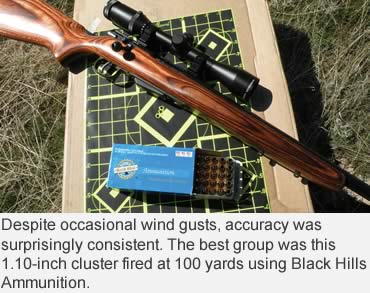 The Lightweight Varminter’s 24-inch semi-heavyweight barrel tapers from 1.12 inches at the receiver to .704 inch at the recessed muzzle. Barrel and action are polished and deeply blued. The barrel is generously free-floated, which promotes accuracy.
The Lightweight Varminter’s 24-inch semi-heavyweight barrel tapers from 1.12 inches at the receiver to .704 inch at the recessed muzzle. Barrel and action are polished and deeply blued. The barrel is generously free-floated, which promotes accuracy.
The machine-jeweled bolt is 7 3/4 inches long and has Savage laser-engraved on the body. The bolt face is deeply recessed. A spring-loaded plunger ejects empties.
Lifting the bolt handle 60 degrees unlocks the action. The two-position safety doesn’t lock the bolt when engaged. This allows you to remove a round from the chamber without disengaging the safety.
The detachable magazine is made of a lightweight but strong synthetic material, as are the trigger guard and magazine well assembly. Immediately ahead of the magazine, a release protrudes 3/8 inch beneath the stock but does not interfere with carrying.
The magazine holds four single-stacked rounds. The fourth round is a very snug fit; loading it can be a struggle.
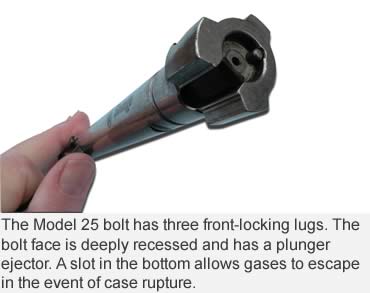 One good thing about the magazine is that you can ignore it and load singles by dropping them into the ejection port and closing the bolt. This can’t be done with Mauser-like rifles that have controlled-round feeding. When I’m at a populous prairie dog town and shooting action is hot, I prefer to load rounds one at a time. For me, this is faster and easier than bothering with a magazine.
One good thing about the magazine is that you can ignore it and load singles by dropping them into the ejection port and closing the bolt. This can’t be done with Mauser-like rifles that have controlled-round feeding. When I’m at a populous prairie dog town and shooting action is hot, I prefer to load rounds one at a time. For me, this is faster and easier than bothering with a magazine.
Like other Savage centerfire rifles, the Model 25 features the excellent AccuTrigger. Pull weight is user-adjustable from 1 1/2 to 6 pounds. A small trigger adjustment tool is included, and instructions are easy to follow.
Out of the box, my sample rifle delivered a crisp, clean letoff with just 2 1/2 pounds of pressure. There was no discernible takeup or overtravel. I consider this close to ideal, so I left it alone.
The Model 25 comes with Weaver-style bases pre-installed, a feature more gunmakers would do well to emulate. This rifle has no iron sights, so a good scope is a must.
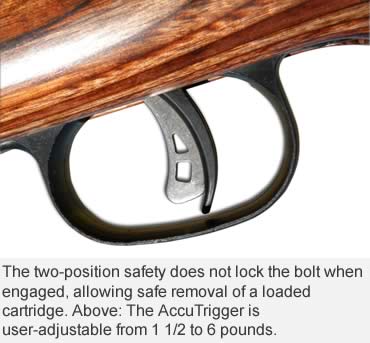 Before heading to my desert range, I mounted a bright, clear Pentax 4-12x40mm Game seeker scope on the rifle. This particular model has graduated stadia marks for long-distance shooting.
Before heading to my desert range, I mounted a bright, clear Pentax 4-12x40mm Game seeker scope on the rifle. This particular model has graduated stadia marks for long-distance shooting.
The first day I attempted to do my testing, a strong wind practically blew me back into my vehicle. Tumbleweeds and my portable target frame took flight. The last time I saw the target frame, it was 30 feet in the air, headed for New Mexico.
Fortunately, the weather was much better the following day. This time, my only worry was sunburn. Setting up the targets and chronograph up took only a few minutes. The weather was nice enough that I spotted several prairie dogs lounging around their burrows — a good portent for varmint rifle testing.
Performance was remarkably consistent. I shot three different factory loads from a bench rest at 100 yards.
There were occasional quartering wind gusts. I tried timing my shots between gusts, and was largely successful. Wind is the primary drawback to shooting in the desert, but mirrors the conditions varmint shooters typically face. In prairie dog country, the wind almost always blows — and hard! In Wyoming, I’ve measured gusts at 35 miles per hour.
Four three-shot groups were averaged for each kind of ammo. Group sizes varied only a little. None of the groups exceeded 1.10 inches, and the best, produced by Black Hills Ammunition, measured 0.624 inch. Accuracy was surprisingly good.
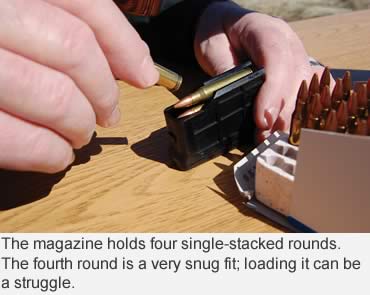 Objectionable recoil is seldom experienced with .223 rifles. However, even a mild-mannered double-deuce can give you a sore shoulder after you fire hundreds of rounds in a single afternoon. This is particularly true with superlight rifles. Recoil has a cumulative effect. At just over 9 pounds (scoped), the Model 25 Lightweight Varminter does a good job of keeping felt recoil at a minimum.
Objectionable recoil is seldom experienced with .223 rifles. However, even a mild-mannered double-deuce can give you a sore shoulder after you fire hundreds of rounds in a single afternoon. This is particularly true with superlight rifles. Recoil has a cumulative effect. At just over 9 pounds (scoped), the Model 25 Lightweight Varminter does a good job of keeping felt recoil at a minimum.
I like Savage’s Model 25 Lightweight Varminter. Compared to most bull-barreled prairie dog rifles I own, it’s much less burdensome to tote. Accuracy is almost as good. Only a few of my heavyweight .223s and .22-250s are consistently capable of half-MOA accuracy, and the Model 25 comes close to that.
I have several custom .223s that, at 5 1/2 pounds, are considerably lighter. These rifles shoot sub-half-inch groups for three or four shots, but when the barrel heats up, the groups begin to spread. This isn’t a problem if the barrel cools down, but that seldom happens on most prairie dog shoots.
The Lightweight Varminter is available in .22 Hornet, .223 Remington and .204 Ruger. The Lightweight Varminter T and Walking Varminter are offered in .222 Remington, 5.7x28mm and 5.45x39mm.
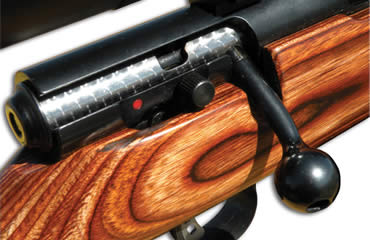 One advantage of using a portable shooting bench in desert country is that when you’re finished punching paper, you can go hunting. It was an unseasonably warm spring day, and a few adventurous prairie dogs had emerged to sun themselves on mounds. I dispatched a baker’s dozen of the rodents lounging within 70 to 250 yards of my bench. Thanks to the gun’s excellent trigger and accuracy, the bullets almost always hit where I aimed.
One advantage of using a portable shooting bench in desert country is that when you’re finished punching paper, you can go hunting. It was an unseasonably warm spring day, and a few adventurous prairie dogs had emerged to sun themselves on mounds. I dispatched a baker’s dozen of the rodents lounging within 70 to 250 yards of my bench. Thanks to the gun’s excellent trigger and accuracy, the bullets almost always hit where I aimed.
After exhausting the nearby supply of accommodating targets, I grabbed a Stony Point Steady-Styx bipod and began walking toward another dog town. After covering 200 yards, I was glad I wasn’t toting one of the heavyweight varmint rifles from my safe.
I’m getting old and creaky enough that I avoid long hikes and heavy loads. My legs aren’t what they used to be. At my age, warranties begin to expire.
Read Recent GunHunter Articles:
• How to Read a Ballistics Chart: All those columns, numbers and abbreviations become clear as you explore.
• The .30-06 Cartridge Family: Offspring of the .30-06 are popular and effective, just like their Ma.
This article first appeared in the August 2011 issue of Buckmasters GunHunter Magazine. Subscribe today to have GunHunter delivered to your home.